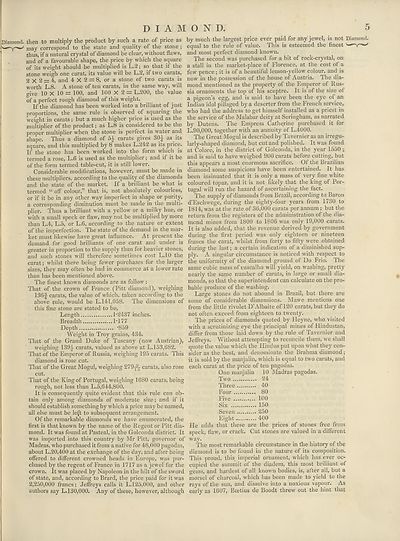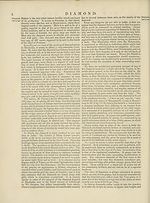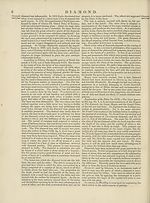Encyclopaedia Britannica > Volume 8, DIA-England
(15) Page 5
Download files
Complete book:
Individual page:
Thumbnail gallery: Grid view | List view

DIAMOND.
Diamond, then to multiply the product by such a rate of price as
may correspond to the state and quality of the stone ;
thus, if a natural crystal of diamond be clear, without flaws,
and of a favourable shape, the price by which the square
of its weight should be multiplied is L.2; so that it the
stone weigh one carat, its value will be L.2, if two carats,
2 X 2 == L and 4 X 2 = 8, or a stone of two carats is
worth L.8. A stone of ten carats, in the same way, will
give 10 X 10 = 100, and 100 X 2 = L.200, the value
of a perfect rough diamond of this weight.
If the diamond has been worked into a brilliant of just
proportions, the same rule is observed of squaring the
weight in carats; but a much higher price is used as the
multiplier of the product; as L.8 is considered to be the
proper multiplier when the stone is perfect in water and
shape. Thus a diamond of 5^ carats gives 301 as its
square, and this multiplied by 8 makes L.242 as its price.
If the stone has been worked into the form which is
termed a rose, L.6 is used as the multiplier; and if it be
of the form termed table-cut, it is still lower.
Considerable modifications, however, must be made in
these multipliers, according to the quality of the diamonds
and the state of the market. If a brilliant be what is
termed “ off colour,” that is, not absolutely colourless,
or if it be in any other way imperfect in shape or purity,
a corresponding diminution must be made in the multi¬
plier. Thus a brilliant with a yellow or a milky hue, or
with a small speck or flaw, may not be multiplied by more
than L.4, L.5, or L.6, according to the nature or extent
of the imperfection. The state of the demand in the mar¬
ket must likewise have great influence. At present the
demand for good brilliants of one carat and under is
greater in proportion to the supply than for heavier stones,
and such stones will therefore sometimes cost L.10 the
carat; whilst there being fewer purchases for the larger
sizes, they may often be had in commerce at a lower rate
than has been mentioned above.
The finest known diamonds are as follow:
That of the crown of France (Pitt diamond), weighing
136f carats, the value of which, taken according to the
above tde, WOuld be L. 141,058. The dimensions of
this fine stone are stated to be,
Length 1-2437 inches.
Breadth 1-177
Depth -859
Weight in Troy grains, 434.
That of the Grand Duke of Tuscany (now Austrian),
weighing 139| carats, valued as above at L.153,682.
That of the Emperor of Russia, weighing 195 carats. This
diamond is rose cut.
That of the Great Mogul, weighing 279^- carats, also rose
cut.
That of the King of Portugal, weighing 1680 carats, being
rough, not less than L.5,644,800.
It is consequently quite evident that this rule can ob¬
tain only among diamonds of moderate size; and if it
should establish something by which a price may be named,
all else must be left to subsequent arrangement.
Of the remarkable diamonds we have enumerated, the
first is that known by the name of the Regent or Pitt dia¬
mond. It was found at Pasteal, in the Golconda district. It
was imported into this country by Mr Pitt, governor of
Madras, who purchased it from a native for 48,000 pagodas,
about L.20,400 at the exchange of the day, and after being
offered to different crowned heads in Europe, was pur¬
chased by the regent of France in 1717 as a jewel for the
crown. It was placed by Napoleon in the hilt of the sword
of state, and, according to Brard, the price paid for it was
2,250,000 francs; Jeffreys calls it L.125,000, and other
authors say L.130,000. Any of these, however, although
by much the largest price ever paid for any jewel, is not Diamond,
equal to the rule of value. This is esteemed the finest
and most perfect diamond known.
The second was purchased for a bit of rock-crystal, on
a stall in the market-place of Florence, at the cost of a
few pence; it is of a beautiful lemon-yellow colour, and. is
now in the possession of the house of Austria. The dia¬
mond mentioned as the property of the Emperor of Rus¬
sia ornaments the top of his sceptre. It is of the size of
a pigeon’s egg, and is said to have been the eye of an
Indian idol pillaged by a deserter from the French service,
who had the address to get himself installed as a priest in
the service of the Malabar deity at Seringham, as narrated
by Dutens. The Empress Catherine purchased it for
L.90,000, together with an annuity of L.4000.
The Great Mogul is described by Tavernier as an irregu¬
larly-shaped diamond, but cut and polished. It was found
at Colore, in the district of Golconda, in the year 1550 ;
and is said to have weighed 900 carats before cutting, but
this appears a most enormous sacrifice. Of the Brazilian
diamond some suspicions have been entertained. It has
been insinuated that it is only a mass of very fine white
coloured topaz, and it is not likely that the king of Por¬
tugal will run the hazard of ascertaining the fact.
The supply of diamonds from Brazil, according to Baron
d’Eschwege, during the eighty-four years from 1730 to
1814, was at the rate of 36,000 carats per annum ; but the
return from the registers of the administration of the dia¬
mond mines from 1800 to 1806 was only 19,000 carats.
It is also added, that the revenue derived by government
during the first period was only eighteen or nineteen
francs the carat, whilst from forty to fifty were obtained
during the last; a certain indication of a diminished sup¬
ply. A singular circumstance is noticed with respect to
the uniformity of the diamond ground of Do Frio. The
same cubic mass of cascalho will yield, on washing, pretty
nearly the same number of carats, in large or small dia¬
monds, so that the superintendent can calculate on the pro¬
bable produce of the washing.
Large stones do not abound in Brazil, but there are
some of considerable dimensions. Mawe mentions one
from the little rivulet D’Albaite of 120 carats, but they do
not often exceed from eighteen to twenty.
The prices of diamonds quoted by Heyne, who visited
with a scrutinizing eye the principal mines of Hindustan,
differ from those laid down by the rule of Tavernier and
Jeffreys. Without attempting to reconcile them, we shall
quote the value which the Hindus put upon what they con¬
sider as the best, and denominate the Brahma diamond;
it is sold by the manjalin, which is equal to two carats, and
each carat at the price of ten pagodas.
One manjalin 10 Madras pagodas.
Two 24
Three 40
Four 80
Five 100
Six 150
Seven 250
Eight 400
He adds that these are the prices of stones free from
speck, flaw, or crack. Cut stones are valued in a different
way.
The most remarkable circumstance in the history of the
diamond is to be found in the nature of its composition.
This proud, this imperial ornament, which has ever oc¬
cupied the summit of the diadem, this most brilliant of
gems, and hardest of all known bodies, is, after all, but a
morsel of charcoal, which has been made to yield to the
rays of the sun, and dissolve into a noxious vapour. As
early as 1607, Boetius de Boodt threw out the hint that
Diamond, then to multiply the product by such a rate of price as
may correspond to the state and quality of the stone ;
thus, if a natural crystal of diamond be clear, without flaws,
and of a favourable shape, the price by which the square
of its weight should be multiplied is L.2; so that it the
stone weigh one carat, its value will be L.2, if two carats,
2 X 2 == L and 4 X 2 = 8, or a stone of two carats is
worth L.8. A stone of ten carats, in the same way, will
give 10 X 10 = 100, and 100 X 2 = L.200, the value
of a perfect rough diamond of this weight.
If the diamond has been worked into a brilliant of just
proportions, the same rule is observed of squaring the
weight in carats; but a much higher price is used as the
multiplier of the product; as L.8 is considered to be the
proper multiplier when the stone is perfect in water and
shape. Thus a diamond of 5^ carats gives 301 as its
square, and this multiplied by 8 makes L.242 as its price.
If the stone has been worked into the form which is
termed a rose, L.6 is used as the multiplier; and if it be
of the form termed table-cut, it is still lower.
Considerable modifications, however, must be made in
these multipliers, according to the quality of the diamonds
and the state of the market. If a brilliant be what is
termed “ off colour,” that is, not absolutely colourless,
or if it be in any other way imperfect in shape or purity,
a corresponding diminution must be made in the multi¬
plier. Thus a brilliant with a yellow or a milky hue, or
with a small speck or flaw, may not be multiplied by more
than L.4, L.5, or L.6, according to the nature or extent
of the imperfection. The state of the demand in the mar¬
ket must likewise have great influence. At present the
demand for good brilliants of one carat and under is
greater in proportion to the supply than for heavier stones,
and such stones will therefore sometimes cost L.10 the
carat; whilst there being fewer purchases for the larger
sizes, they may often be had in commerce at a lower rate
than has been mentioned above.
The finest known diamonds are as follow:
That of the crown of France (Pitt diamond), weighing
136f carats, the value of which, taken according to the
above tde, WOuld be L. 141,058. The dimensions of
this fine stone are stated to be,
Length 1-2437 inches.
Breadth 1-177
Depth -859
Weight in Troy grains, 434.
That of the Grand Duke of Tuscany (now Austrian),
weighing 139| carats, valued as above at L.153,682.
That of the Emperor of Russia, weighing 195 carats. This
diamond is rose cut.
That of the Great Mogul, weighing 279^- carats, also rose
cut.
That of the King of Portugal, weighing 1680 carats, being
rough, not less than L.5,644,800.
It is consequently quite evident that this rule can ob¬
tain only among diamonds of moderate size; and if it
should establish something by which a price may be named,
all else must be left to subsequent arrangement.
Of the remarkable diamonds we have enumerated, the
first is that known by the name of the Regent or Pitt dia¬
mond. It was found at Pasteal, in the Golconda district. It
was imported into this country by Mr Pitt, governor of
Madras, who purchased it from a native for 48,000 pagodas,
about L.20,400 at the exchange of the day, and after being
offered to different crowned heads in Europe, was pur¬
chased by the regent of France in 1717 as a jewel for the
crown. It was placed by Napoleon in the hilt of the sword
of state, and, according to Brard, the price paid for it was
2,250,000 francs; Jeffreys calls it L.125,000, and other
authors say L.130,000. Any of these, however, although
by much the largest price ever paid for any jewel, is not Diamond,
equal to the rule of value. This is esteemed the finest
and most perfect diamond known.
The second was purchased for a bit of rock-crystal, on
a stall in the market-place of Florence, at the cost of a
few pence; it is of a beautiful lemon-yellow colour, and. is
now in the possession of the house of Austria. The dia¬
mond mentioned as the property of the Emperor of Rus¬
sia ornaments the top of his sceptre. It is of the size of
a pigeon’s egg, and is said to have been the eye of an
Indian idol pillaged by a deserter from the French service,
who had the address to get himself installed as a priest in
the service of the Malabar deity at Seringham, as narrated
by Dutens. The Empress Catherine purchased it for
L.90,000, together with an annuity of L.4000.
The Great Mogul is described by Tavernier as an irregu¬
larly-shaped diamond, but cut and polished. It was found
at Colore, in the district of Golconda, in the year 1550 ;
and is said to have weighed 900 carats before cutting, but
this appears a most enormous sacrifice. Of the Brazilian
diamond some suspicions have been entertained. It has
been insinuated that it is only a mass of very fine white
coloured topaz, and it is not likely that the king of Por¬
tugal will run the hazard of ascertaining the fact.
The supply of diamonds from Brazil, according to Baron
d’Eschwege, during the eighty-four years from 1730 to
1814, was at the rate of 36,000 carats per annum ; but the
return from the registers of the administration of the dia¬
mond mines from 1800 to 1806 was only 19,000 carats.
It is also added, that the revenue derived by government
during the first period was only eighteen or nineteen
francs the carat, whilst from forty to fifty were obtained
during the last; a certain indication of a diminished sup¬
ply. A singular circumstance is noticed with respect to
the uniformity of the diamond ground of Do Frio. The
same cubic mass of cascalho will yield, on washing, pretty
nearly the same number of carats, in large or small dia¬
monds, so that the superintendent can calculate on the pro¬
bable produce of the washing.
Large stones do not abound in Brazil, but there are
some of considerable dimensions. Mawe mentions one
from the little rivulet D’Albaite of 120 carats, but they do
not often exceed from eighteen to twenty.
The prices of diamonds quoted by Heyne, who visited
with a scrutinizing eye the principal mines of Hindustan,
differ from those laid down by the rule of Tavernier and
Jeffreys. Without attempting to reconcile them, we shall
quote the value which the Hindus put upon what they con¬
sider as the best, and denominate the Brahma diamond;
it is sold by the manjalin, which is equal to two carats, and
each carat at the price of ten pagodas.
One manjalin 10 Madras pagodas.
Two 24
Three 40
Four 80
Five 100
Six 150
Seven 250
Eight 400
He adds that these are the prices of stones free from
speck, flaw, or crack. Cut stones are valued in a different
way.
The most remarkable circumstance in the history of the
diamond is to be found in the nature of its composition.
This proud, this imperial ornament, which has ever oc¬
cupied the summit of the diadem, this most brilliant of
gems, and hardest of all known bodies, is, after all, but a
morsel of charcoal, which has been made to yield to the
rays of the sun, and dissolve into a noxious vapour. As
early as 1607, Boetius de Boodt threw out the hint that
Set display mode to:
![]() Universal Viewer |
Universal Viewer | ![]() Mirador |
Large image | Transcription
Mirador |
Large image | Transcription
Images and transcriptions on this page, including medium image downloads, may be used under the Creative Commons Attribution 4.0 International Licence unless otherwise stated. ![]()
| Encyclopaedia Britannica > Encyclopaedia Britannica > Volume 8, DIA-England > (15) Page 5 |
|---|
| Permanent URL | https://digital.nls.uk/193323200 |
|---|
| Attribution and copyright: |
|
|---|
| Description | Ten editions of 'Encyclopaedia Britannica', issued from 1768-1903, in 231 volumes. Originally issued in 100 weekly parts (3 volumes) between 1768 and 1771 by publishers: Colin Macfarquhar and Andrew Bell (Edinburgh); editor: William Smellie: engraver: Andrew Bell. Expanded editions in the 19th century featured more volumes and contributions from leading experts in their fields. Managed and published in Edinburgh up to the 9th edition (25 volumes, from 1875-1889); the 10th edition (1902-1903) re-issued the 9th edition, with 11 supplementary volumes. |
|---|---|
| Additional NLS resources: |
|

